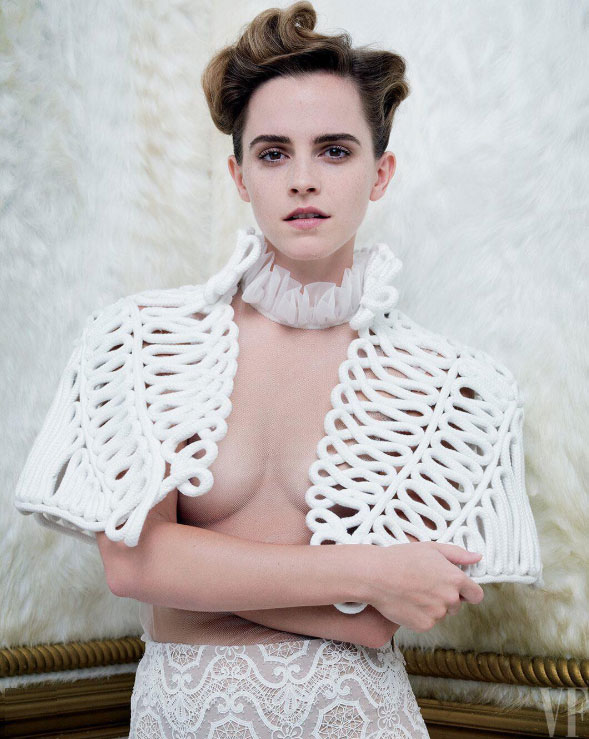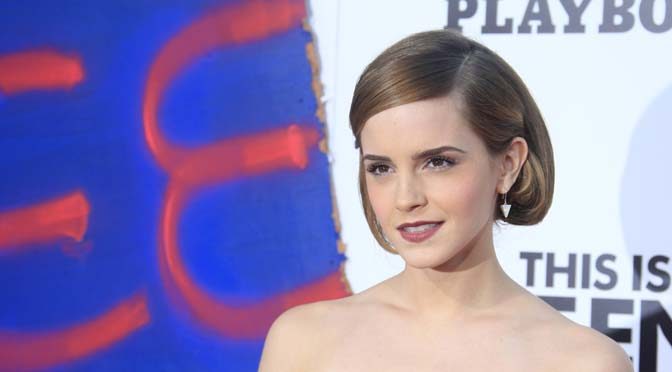A self-confessed feminist is shown on the cover of a glossy magazine, lightly dressed, with a coarse-mesh Burberry bolero over her shoulders, and obviously naked underneath. Her breasts are half visible. Former teen idol Emma Watson has herself staged as a Victorian rebel for the March issue of Vanity Fair. And the Internet community is running up a storm.

The Double Standard for Female Artists
The debate and controversy that followed the publication of this image show the double standard that we, female artists, face today. Especially when working with erotic themes and defending feminist causes, like Emma Watson. That’s why it’s worth taking a closer look at the reactions after the Vanity Fair photo shoot.
The Phenomenon of Image Transformation in Young Stars
Normally, such a photo of a young Hollywood star would merely merit a mention, not a debate. Especially since Disney discoveries, from Lindsay Lohan to Miley Cyrus, Selena Gomez, or Ariana Grande, all had their libertine phase, where they tried to break away from their uptight image.
This kind of evolution is not new. Even Romy Schneider used daring appearances in films at the end of the 60s to break away from her stuffy image as Empress Sissi. In films like Deray’s “The Swimmingpool” Deville’s “Love at the top,” or Zulawski’s “That Most Important Thing: Love,” she appeared completely nude, frightening all those who wanted to see her as a chaste romantic.
Emma Watson: From Hermione to Feminist
Emma Watson has a very similar journey with her role as Hermione Granger in the eight Harry Potter films. However, in her subsequent roles – with the possible exception of Coppola’s “The Bling Ring” – she has largely remained true to her image as a good girl.
On the contrary, she has presented herself as a convinced feminist, expressing her opinions in various interviews. She became a UN Special Envoy for Women’s and Girls’ Rights and, in this capacity, contributed to the development of the #HeForShe campaign, which fights for gender equality, strengthening women’s rights, and ending violence against women and girls.
“Our Shared Shelf”: Watson’s Feminist Book Club
She launches the feminist book club “Our Shared Shelf” on the GoodReads reading platform. Each month, a new title on the theme of gender equality will be presented. The first book was the autobiography of American activist Gloria Steinem, “My Life on the Road.” Currently, Margaret Atwood’s novel “The Handmaid’s Tale” is under discussion, an oppressive dystopia about an America where religious fundamentalists have taken power and women are reduced to breeding machines.
On the book club’s homepage, Emma Watson explains her intention behind “Our Shared Shelf”:
“As part of my work with the UN, I have read as many books and essays on equality as possible. There are so many fantastic things. Funny, inspiring, sad, thought-provoking, inspiring. I discovered so many things that I sometimes felt like my head was going to explode… I decided to create a feminist book club to share what I’m learning and hear your thoughts.”
The Controversial Vanity Fair Photo Shoot
Emma Watson thus appears for the first time in public in light attire. For the March issue of Vanity Fair, she was photographed wearing a white stole that largely reveals her chest. Tim Walker is the photographer. And the photo plays with Emma’s erotic charisma: mouth open, eyelids slightly lowered, gaze fixed directly on the camera.
The English tabloid The Sun publishes the photo in full page a few days before the release of Vanity Fair, under the title “Beauty & the breasts,” thus reaching an audience that would probably never buy a more sophisticated glamour magazine and that has little interest in Emma Watson’s interview. The brief text accompanying the photo in The Sun logically begins with “DING-dong, Belle.”
The Storm of Criticism and Watson’s Response
A storm of criticism immediately breaks out on social media. Journalist and radio host Julia Hartley-Brewer is one of the first to tweet a photo of the Sun’s page, accompanied by a sarcastic comment: “Emma Watson: ‘Feminism, feminism… Pay inequality… Why, oh why, am I not taken seriously… Feminism… Oh, and here are my breasts!'” (https://twitter.com/JuliaHB1/status/836873834414366720)
Emma Watson responds in an interview with Reuters news agency during a promotional date for “Beauty and the Beast.”
“I’m annoyed by all the misconceptions about feminism. Feminism is about giving women choice. Feminism is not a stick with which to beat other women. It’s about freedom, liberation, equality. I really don’t see what my breasts have to do with it. It’s very confusing.”
In this interview, her partner in “Beauty and the Beast,” Dan Stevens, asks her with annoyance what this whole controversy is really about. Emma Watson searches for words and, together, they highlight the absurdity of the attacks: “People say I can’t be a feminist and have… breasts at the same time.” (https://www.youtube-nocookie.com/embed/t7OvCcxVlFo)
The Beyoncé Controversy: A Misunderstanding?
It’s true, two years earlier, she had given an interview to Wonderland magazine in which she thoughtfully discussed Beyoncé’s visual album, “Beyoncé,” and also related it to her feminism: “When I saw the videos, I felt a great contradiction. On one hand, she places herself in the category of feminists, on the other hand, the camera shows her in a very masculine, very voyeuristic way,” she had said.
But this quote gives a very truncated picture of Emma Watson’s position. After all, the media love sensationalism, and harsh criticism always passes better than a thoughtful and balanced statement, like the one she actually made in the interview. After the publication of the Vanity Fair photos, the excerpt from the two-year-old interview was used to accuse Emma Watson of hypocrisy and double standards. A storm of criticism raged on Twitter and Instagram.
In response, Emma Watson shared the original text of the complete interview on Twitter. It clearly shows her admiration for Beyoncé, especially for her feminist work. She talks about Beyoncé’s courage in opposing MTV’s usual sensationalism with these videos. For her, these videos are signs of sexual emancipation. She says that Beyoncé’s videos give her the feeling that “she can be a feminist, an intellectual, all these things, but she can also embrace her femininity, her beauty, all these things that, according to her, contradicted her message or her beliefs.” Emma Watson concludes by saying: “That’s really what’s most interesting about this album. It’s so inclusive and addresses feminism, femininity, and women’s empowerment from a very broad angle.” (https://twitter.com/EmmaWatson/status/839005241978675200)
Feminism and Eroticism: A Field of Tension
The debate around Emma Watson’s photo shoot for Vanity Fair shows the tensions that still exist between eroticism and feminism. The concept of self-determination over one’s own body frightens many people. Conservative forces, in particular, oppose any attempt at women’s autonomy, which also includes the right to show one’s body.
Gloria Steinem, founder and editor-in-chief of the feminist magazine “Ms.,” sums up this concept of bodily self-determination well when asked for her opinion on the controversy surrounding Emma Watson: “Feminists can wear whatever they want. They should be able to walk naked in the street safely.” (https://www.tmz.com/2017/03/03/gloria-steinem-emma-watson-feminism/)
Alice Schwarzer’s Position
The Badische Zeitung newspaper tries to associate Alice Schwarzer with the controversy: “Feminists don’t want women to be seen as dolls, reduced to their bodies and systematically underestimated. But does that mean they should be forbidden from being sexy? German feminist Alice Schwarzer has a clear answer to this question: according to her, female eroticism is traditionally associated with male power – and female powerlessness.”
Alice Schwarzer responds quickly: “Before, there was still the term ‘erotic.’ Now, everything is simply labeled ‘pornographic,’ and that’s generally the case. But what is really the difference between erotic and pornographic? Emma’s photo has nothing to do with (self-)humiliating exhibition, but everything to do with a confident staging! She tells us: I am intelligent, I am emancipated – and I am sensual. It’s the complete opposite of pornography.”
Media Mechanisms and Feminist Solidarity
How does Schwarzer come to address the subject of “pornography”? The quote from the Badische Zeitung – taken out of context – refers to the current anti-pornography movement. But its pioneers, like Sheila Jeffries, Karen Boyle, or Pamela Paul, are not at all interested in Emma Watson’s photo shoot for Vanity Fair. Even Gail Dines, who was still amusing herself on Facebook about Emma Watson’s attempts to impose a feminist message on “Beauty and the Beast,” hasn’t said a word about the current photos.
The attacks didn’t come from the anti-pornography feminist camp, even if some media presented it that way. It’s obvious that the photos were only used as a pretext to discredit a feminist activist and her cause. The fact that quotes taken out of context were also used for this purpose corresponds to the mechanisms of the media, and not just social networks.
Conclusion: The Right to Bodily Self-Determination
As artists, we can counter this by ensuring that the audience is as broad as possible. We can help spread the facts and show our solidarity with those who are currently caught in the crossfire of conservative criticism in the media. Bare breasts are certainly not a symbol in themselves. There is the voyeuristic gaze, but there is also the right to bodily self-determination. Emma Watson exercised it.

